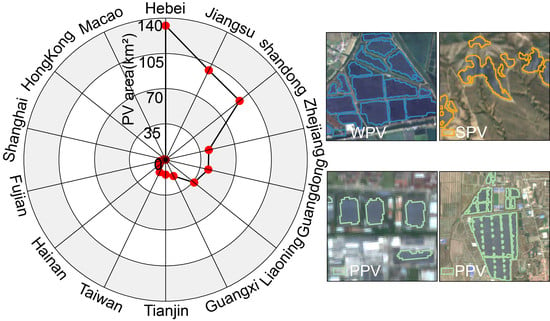Mapping Photovoltaic Panels in Coastal China Using Sentinel-1 and Sentinel-2 Images and Google Earth Engine
Abstract
:1. Introduction
2. Materials and Methods
2.1. Study Area
2.2. Data Sources
2.2.1. Satellite Datasets
2.2.2. Other Auxiliary Data
2.3. Methods
2.3.1. Preprocessing of Satellite Images and Calculation of Characteristic Bands
2.3.2. Build Classifier and Make Post-Classification Processing
2.3.3. Differentiation of PV Panels
2.3.4. Accuracy Assessment
3. Results
3.1. Extraction Results and Precision Verification
3.1.1. Accurate Assessment of the Different Processing Maps
3.1.2. Accuracy of Different Types of PV
3.2. Spatial Distribution of Photovoltaic Panels
3.3. The Impact of Photovoltaic Panels on Vegetation
3.4. Comparison of Different Data
4. Discussion
4.1. Reliability of the PV Panel Mapping
4.2. Source of Errors in the PV Panel Map
4.3. Potential Applications of the Identification Approach, and Challenges Faced by PV Development
5. Conclusions
Author Contributions
Funding
Data Availability Statement
Acknowledgments
Conflicts of Interest
References
- Asif, M.; Muneer, T. Energy supply, its demand and security issues for developed and emerging economies. Renew. Sustain. Energy Rev. 2007, 11, 1388–1413. [Google Scholar] [CrossRef]
- Wrigley, E.A. Energy and the English industrial revolution. Philos. Trans. R. Soc. A Math. Phys. Eng. Sci. 2013, 371, 20110568. [Google Scholar] [CrossRef] [PubMed]
- Shindell, D.; Smith, C.J. Climate and air-quality benefits of a realistic phase-out of fossil fuels. Nature 2019, 573, 408–411. [Google Scholar] [CrossRef] [Green Version]
- Lin, B.; Zhu, J. The role of renewable energy technological innovation on climate change: Empirical evidence from China. Sci. Total Environ. 2019, 659, 1505–1512. [Google Scholar] [CrossRef]
- Zheng, H.; Song, M.; Shen, Z. The evolution of renewable energy and its impact on carbon reduction in China. Energy 2021, 237, 121639. [Google Scholar] [CrossRef]
- Williams, J.H.; DeBenedictis, A.; Ghanadan, R.; Mahone, A.; Moore, J.; Morrow, W.R., III; Price, S.; Torn, M.S. The technology path to deep greenhouse gas emissions cuts by 2050: The pivotal role of electricity. Science 2012, 335, 53–59. [Google Scholar] [CrossRef] [Green Version]
- Kannan, N.; Vakeesan, D. Solar energy for future world:-A review. Renew. Sustain. Energy Rev. 2016, 62, 1092–1105. [Google Scholar] [CrossRef]
- Parida, B.; Iniyan, S.; Goic, R. A review of solar photovoltaic technologies. Renew. Sustain. Energy Rev. 2011, 15, 1625–1636. [Google Scholar] [CrossRef]
- Zhang, Z.; Chen, M.; Zhong, T.; Zhu, R.; Qian, Z.; Zhang, F.; Yang, Y.; Zhang, K.; Santi, P.; Wang, K. Carbon mitigation potential afforded by rooftop photovoltaic in China. Nat. Commun. 2023, 14, 2347. [Google Scholar] [CrossRef]
- Liu, J.; Lu, Y. Research on the evaluation of China’s photovoltaic policy driving ability under the background of carbon neutrality. Energy 2022, 250, 123809. [Google Scholar] [CrossRef]
- Louwen, A.; Van Sark, W.G.; Faaij, A.P.; Schropp, R.E. Re-assessment of net energy production and greenhouse gas emissions avoidance after 40 years of photovoltaics development. Nat. Commun. 2016, 7, 13728. [Google Scholar] [CrossRef] [Green Version]
- Chang, I.-S.; Liu, H.; Wu, J.; Zhou, C.; Zheng, L. Process analysis of poverty eradication in China: A case study on photovoltaic projects for poverty alleviation. Environ. Impact Assess. Rev. 2021, 90, 106630. [Google Scholar] [CrossRef]
- Vaverková, M.D.; Winkler, J.; Uldrijan, D.; Ogrodnik, P.; Vespalcová, T.; Aleksiejuk-Gawron, J.; Adamcová, D.; Koda, E. Fire hazard associated with different types of photovoltaic power plants: Effect of vegetation management. Renew. Sustain. Energy Rev. 2022, 162, 112491. [Google Scholar] [CrossRef]
- Yang, Y.; Xia, S. China must balance renewable energy sites. Science 2022, 378, 609. [Google Scholar] [CrossRef]
- Romano, V.; Agresti, A.; Verduci, R.; D’Angelo, G. Advances in perovskites for photovoltaic applications in space. ACS Energy Lett. 2022, 7, 2490–2514. [Google Scholar] [CrossRef]
- Chen, Z.; Yu, B.; Li, Y.; Wu, Q.; Wu, B.; Huang, Y.; Wu, S.; Yu, S.; Mao, W.; Zhao, F. Assessing the potential and utilization of solar energy at the building-scale in Shanghai. Sustain. Cities Soc. 2022, 82, 103917. [Google Scholar] [CrossRef]
- Qiu, T.; Wang, L.; Lu, Y.; Zhang, M.; Qin, W.; Wang, S.; Wang, L. Potential assessment of photovoltaic power generation in China. Renew. Sustain. Energy Rev. 2022, 154, 111900. [Google Scholar] [CrossRef]
- Gallardo-Saavedra, S.; Hernández-Callejo, L.; Duque-Perez, O. Image resolution influence in aerial thermographic inspections of photovoltaic plants. IEEE Trans. Ind. Inform. 2018, 14, 5678–5686. [Google Scholar] [CrossRef]
- Liao, M.; Zhang, Z.; Jia, J.; Xiong, J.; Han, M. Mapping China’s photovoltaic power geographies: Spatial-temporal evolution, provincial competition and low-carbon transition. Renew. Energy 2022, 191, 251–260. [Google Scholar] [CrossRef]
- Mauro, G.; Lughi, V. Mapping land use impact of photovoltaic farms via crowdsourcing in the Province of Lecce (Southeastern Italy). Sol. Energy 2017, 155, 434–444. [Google Scholar] [CrossRef] [Green Version]
- Jiang, H.; Yao, L.; Lu, N.; Qin, J.; Liu, T.; Liu, Y.; Zhou, C. Multi-resolution dataset for photovoltaic panel segmentation from satellite and aerial imagery. Earth Syst. Sci. Data 2021, 13, 5389–5401. [Google Scholar] [CrossRef]
- Jie, Y.; Ji, X.; Yue, A.; Chen, J.; Deng, Y.; Chen, J.; Zhang, Y. Combined multi-layer feature fusion and edge detection method for distributed photovoltaic power station identification. Energies 2020, 13, 6742. [Google Scholar] [CrossRef]
- Xia, Z.; Li, Y.; Guo, X.; Chen, R. High-resolution mapping of water photovoltaic development in China through satellite imagery. Int. J. Appl. Earth Obs. Geoinf. 2022, 107, 102707. [Google Scholar] [CrossRef]
- Stid, J.T.; Shukla, S.; Anctil, A.; Kendall, A.D.; Rapp, J.; Hyndman, D.W. Solar array placement, electricity generation, and cropland displacement across California’s Central Valley. Sci. Total Environ. 2022, 835, 155240. [Google Scholar] [CrossRef]
- Kuo, C.-F.J.; Chen, S.-H.; Huang, C.-Y. Automatic detection, classification and localization of defects in large photovoltaic plants using unmanned aerial vehicles (UAV) based infrared (IR) and RGB imaging. Energy Convers. Manag. 2023, 276, 116495. [Google Scholar]
- Plakman, V.; Rosier, J.; van Vliet, J. Solar park detection from publicly available satellite imagery. GISci. Remote Sens. 2022, 59, 461–480. [Google Scholar] [CrossRef]
- Czirjak, D.W. Detecting photovoltaic solar panels using hyperspectral imagery and estimating solar power production. J. Appl. Remote Sens. 2017, 11, 026007. [Google Scholar] [CrossRef]
- Du, B.; He, Y.; He, Y.; Duan, J.; Zhang, Y. Intelligent classification of silicon photovoltaic cell defects based on eddy current thermography and convolution neural network. IEEE Trans. Ind. Inform. 2019, 16, 6242–6251. [Google Scholar] [CrossRef]
- Kruitwagen, L.; Story, K.; Friedrich, J.; Byers, L.; Skillman, S.; Hepburn, C. A global inventory of photovoltaic solar energy generating units. Nature 2021, 598, 604–610. [Google Scholar] [CrossRef] [PubMed]
- Ortiz, A.; Negandhi, D.; Mysorekar, S.R.; Nagaraju, S.K.; Kiesecker, J.; Robinson, C.; Bhatia, P.; Khurana, A.; Wang, J.; Oviedo, F. An artificial intelligence dataset for solar energy locations in India. Sci. Data 2022, 9, 497. [Google Scholar] [CrossRef] [PubMed]
- Zhang, X.; Xu, M. Assessing the effects of photovoltaic powerplants on surface temperature using remote sensing techniques. Remote Sens. 2020, 12, 1825. [Google Scholar] [CrossRef]
- Guoqing, L.; Hernandez, R.R.; Blackburn, G.A.; Davies, G.; Hunt, M.; Whyatt, J.D.; Armstrong, A. Ground-mounted photovoltaic solar parks promote land surface cool islands in arid ecosystems. Renew. Sustain. Energy Transit. 2021, 1, 100008. [Google Scholar] [CrossRef]
- Xia, Z.; Li, Y.; Zhang, W.; Guo, S.; Zheng, L.; Jia, N.; Chen, R.; Guo, X.; Du, P. Quantitatively distinguishing the impact of solar photovoltaics programs on vegetation in dryland using satellite imagery. Land Degrad. Dev. 2023; Early View. [Google Scholar] [CrossRef]
- Yang, J.; Huang, X. The 30 m annual land cover dataset and its dynamics in China from 1990 to 2019. Earth Syst. Sci. Data 2021, 13, 3907–3925. [Google Scholar] [CrossRef]
- Xia, Z.; Li, Y.; Chen, R.; Sengupta, D.; Guo, X.; Xiong, B.; Niu, Y. Mapping the rapid development of photovoltaic power stations in northwestern China using remote sensing. Energy Rep. 2022, 8, 4117–4127. [Google Scholar] [CrossRef]
- Zhang, X.; Zeraatpisheh, M.; Rahman, M.M.; Wang, S.; Xu, M. Texture is important in improving the accuracy of mapping photovoltaic power plants: A case study of Ningxia Autonomous Region, China. Remote Sens. 2021, 13, 3909. [Google Scholar] [CrossRef]
- Tucker, C.J. Red and photographic infrared linear combinations for monitoring vegetation. Remote Sens. Environ. 1979, 8, 127–150. [Google Scholar] [CrossRef] [Green Version]
- Zha, Y.; Gao, J.; Ni, S. Use of normalized difference built-up index in automatically mapping urban areas from TM imagery. Int. J. Remote Sens. 2003, 24, 583–594. [Google Scholar] [CrossRef]
- McFeeters, S.K. The use of the Normalized Difference Water Index (NDWI) in the delineation of open water features. Int. J. Remote Sens. 1996, 17, 1425–1432. [Google Scholar] [CrossRef]
- Breiman, L. Random forests. Mach. Learn. 2001, 45, 5–32. [Google Scholar] [CrossRef] [Green Version]
- Belgiu, M.; Drăguţ, L. Random forest in remote sensing: A review of applications and future directions. ISPRS J. Photogramm. Remote Sens. 2016, 114, 24–31. [Google Scholar] [CrossRef]
- Colditz, R.R. An evaluation of different training sample allocation schemes for discrete and continuous land cover classification using decision tree-based algorithms. Remote Sens. 2015, 7, 9655–9681. [Google Scholar] [CrossRef] [Green Version]
- Du, P.; Samat, A.; Waske, B.; Liu, S.; Li, Z. Random forest and rotation forest for fully polarized SAR image classification using polarimetric and spatial features. ISPRS J. Photogramm. Remote Sens. 2015, 105, 38–53. [Google Scholar] [CrossRef]
- Congalton, R.G. A review of assessing the accuracy of classifications of remotely sensed data. Remote Sens. Environ. 1991, 37, 35–46. [Google Scholar] [CrossRef]
- Stehman, S.V.; Foody, G.M. Key issues in rigorous accuracy assessment of land cover products. Remote Sens. Environ. 2019, 231, 111199. [Google Scholar] [CrossRef]
- Zhang, X.; Xu, M.; Wang, S.; Huang, Y.; Xie, Z. Mapping photovoltaic power plants in China using Landsat, random forest, and Google Earth Engine. Earth Syst. Sci. Data 2022, 14, 3743–3755. [Google Scholar] [CrossRef]
- Wang, X.; Xiao, X.; Zou, Z.; Hou, L.; Qin, Y.; Dong, J.; Doughty, R.B.; Chen, B.; Zhang, X.; Chen, Y. Mapping coastal wetlands of China using time series Landsat images in 2018 and Google Earth Engine. ISPRS J. Photogramm. Remote Sens. 2020, 163, 312–326. [Google Scholar] [CrossRef]
- Flood, N. Seasonal composite Landsat TM/ETM+ images using the medoid (a multi-dimensional median). Remote Sens. 2013, 5, 6481–6500. [Google Scholar] [CrossRef] [Green Version]
- Pal, M. Random forest classifier for remote sensing classification. Int. J. Remote Sens. 2005, 26, 217–222. [Google Scholar] [CrossRef]
- Van Tricht, K.; Gobin, A.; Gilliams, S.; Piccard, I. Synergistic use of radar Sentinel-1 and optical Sentinel-2 imagery for crop mapping: A case study for Belgium. Remote Sens. 2018, 10, 1642. [Google Scholar] [CrossRef] [Green Version]
- Liu, C.; Zhang, Q.; Wang, H. Cost-benefit analysis of waste photovoltaic module recycling in China. Waste Manag. 2020, 118, 491–500. [Google Scholar] [CrossRef]
- Herez, A.; El Hage, H.; Lemenand, T.; Ramadan, M.; Khaled, M. Review on photovoltaic/thermal hybrid solar collectors: Classifications, applications and new systems. Sol. Energy 2020, 207, 1321–1347. [Google Scholar] [CrossRef]
- Tawalbeh, M.; Al-Othman, A.; Kafiah, F.; Abdelsalam, E.; Almomani, F.; Alkasrawi, M. Environmental impacts of solar photovoltaic systems: A critical review of recent progress and future outlook. Sci. Total Environ. 2021, 759, 143528. [Google Scholar] [CrossRef] [PubMed]
- Sun, Y.; Zhu, D.; Li, Y.; Wang, R.; Ma, R. Spatial modelling the location choice of large-scale solar photovoltaic power plants: Application of interpretable machine learning techniques and the national inventory. Energy Convers. Manag. 2023, 289, 117198. [Google Scholar] [CrossRef]
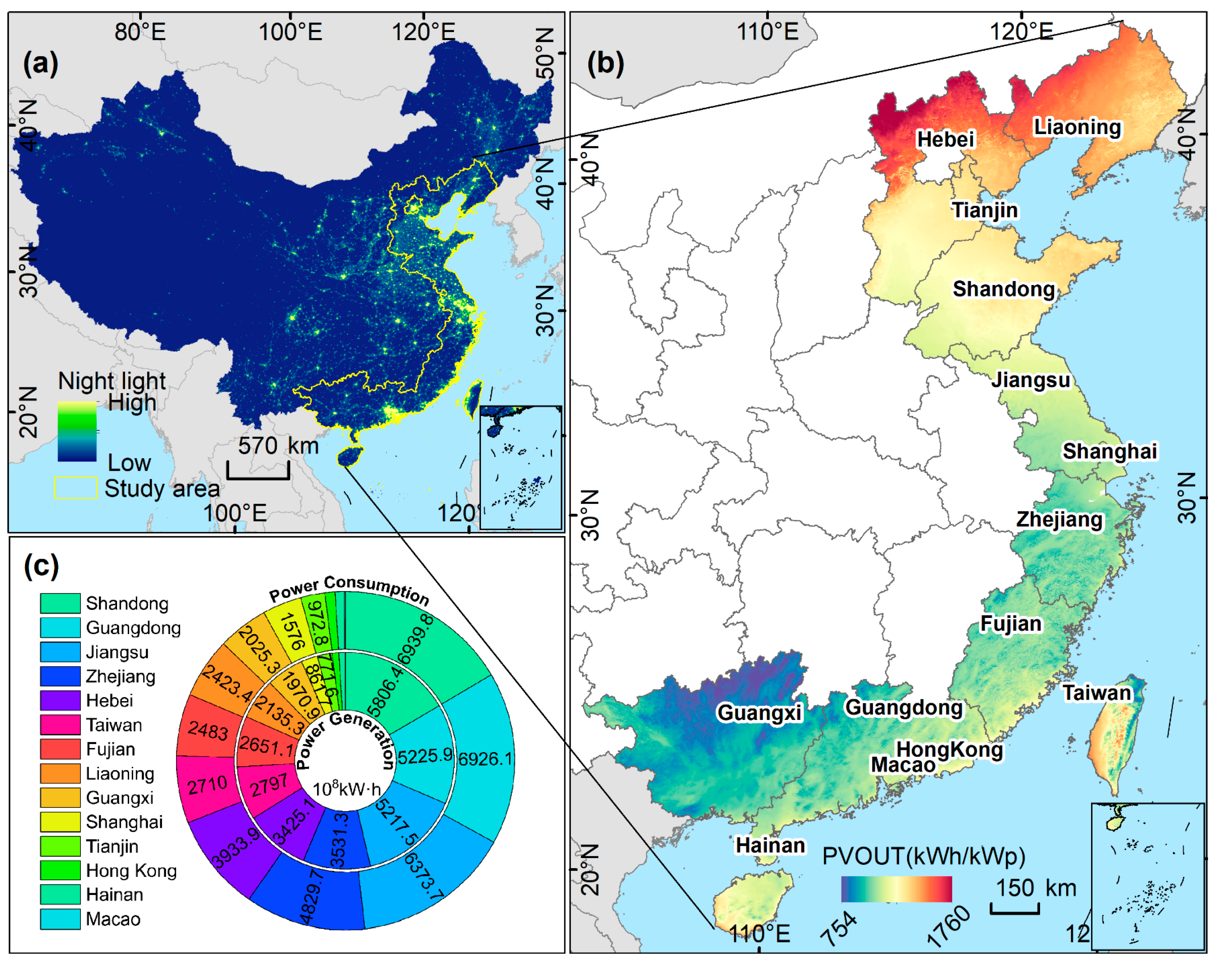
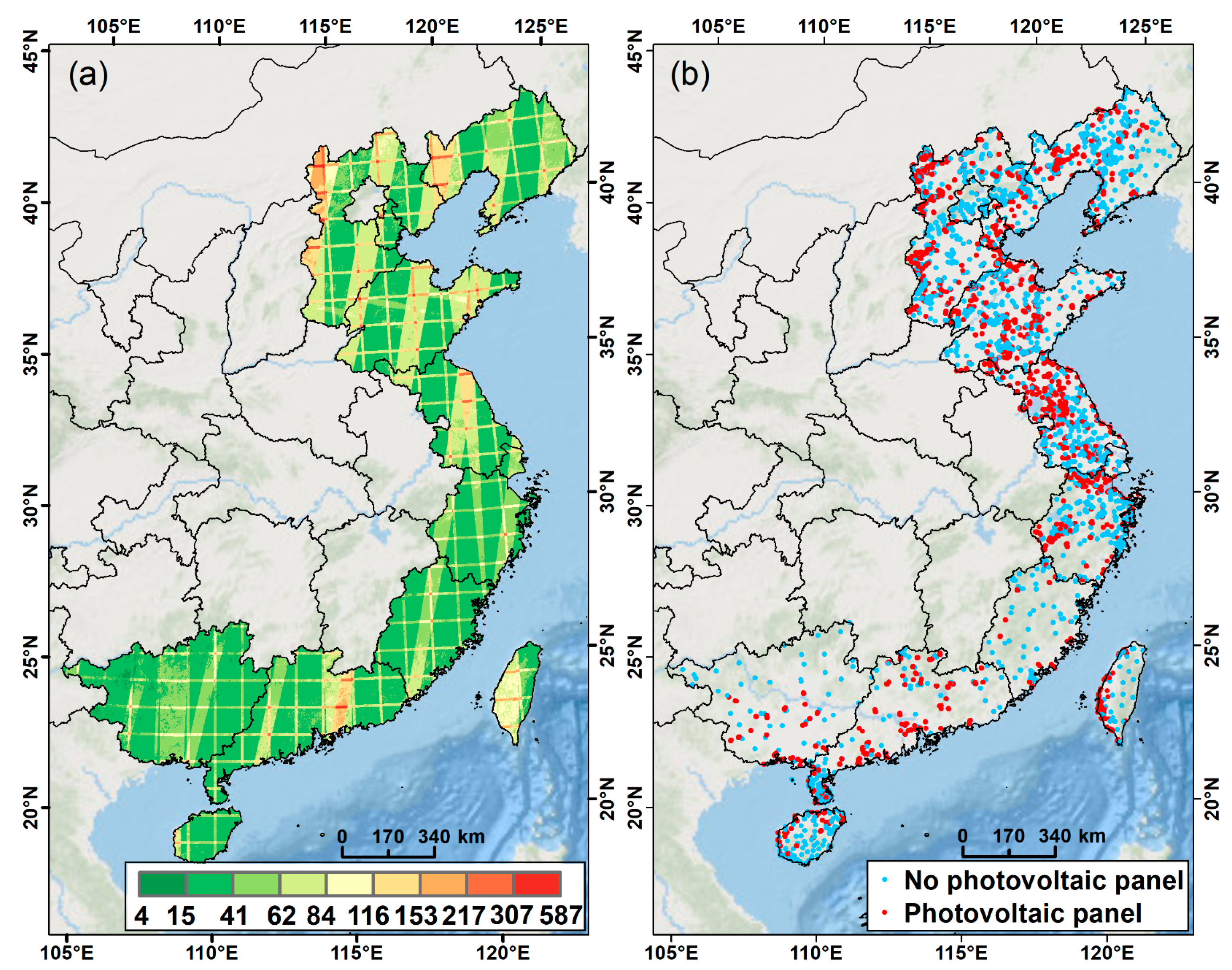
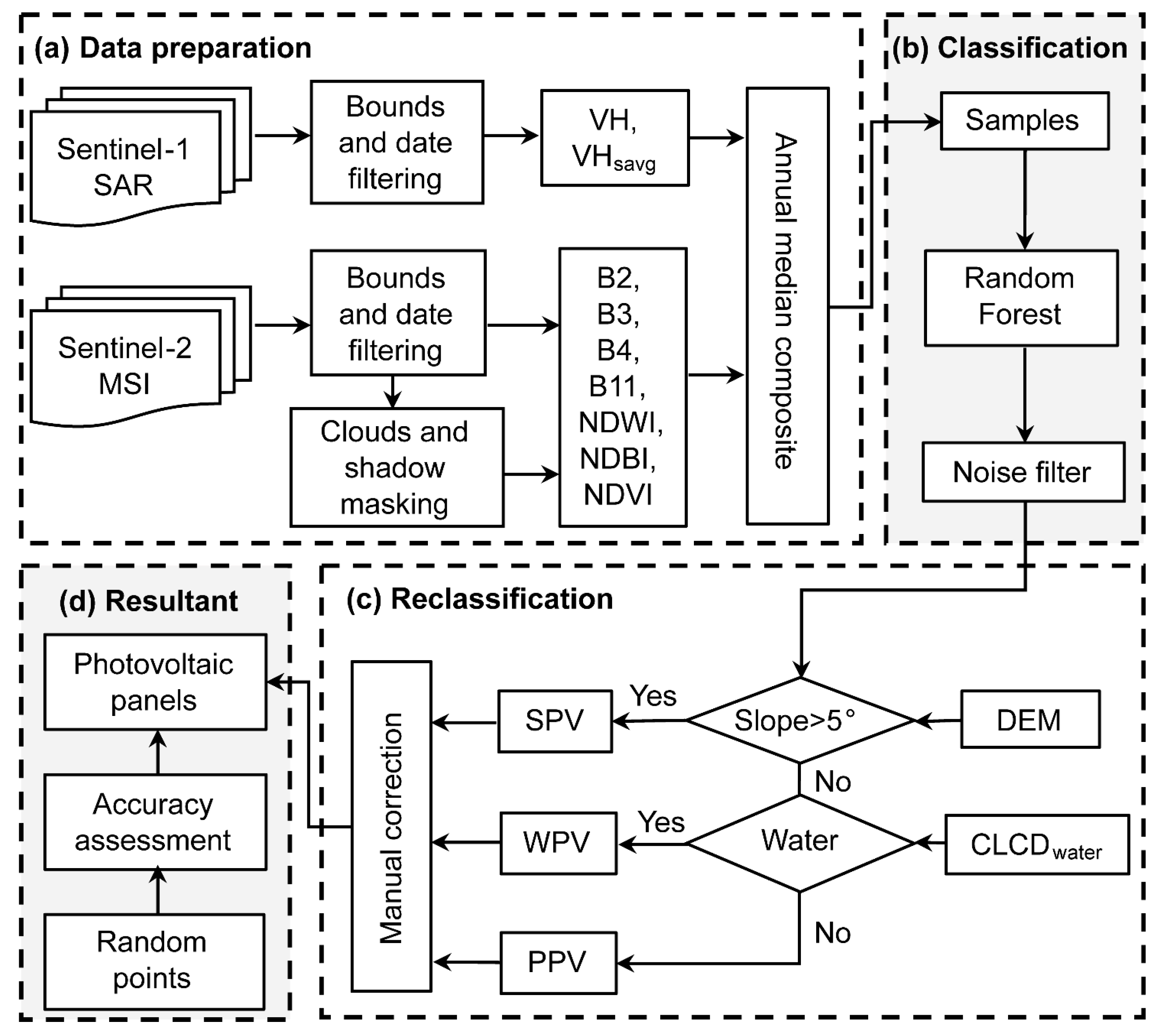
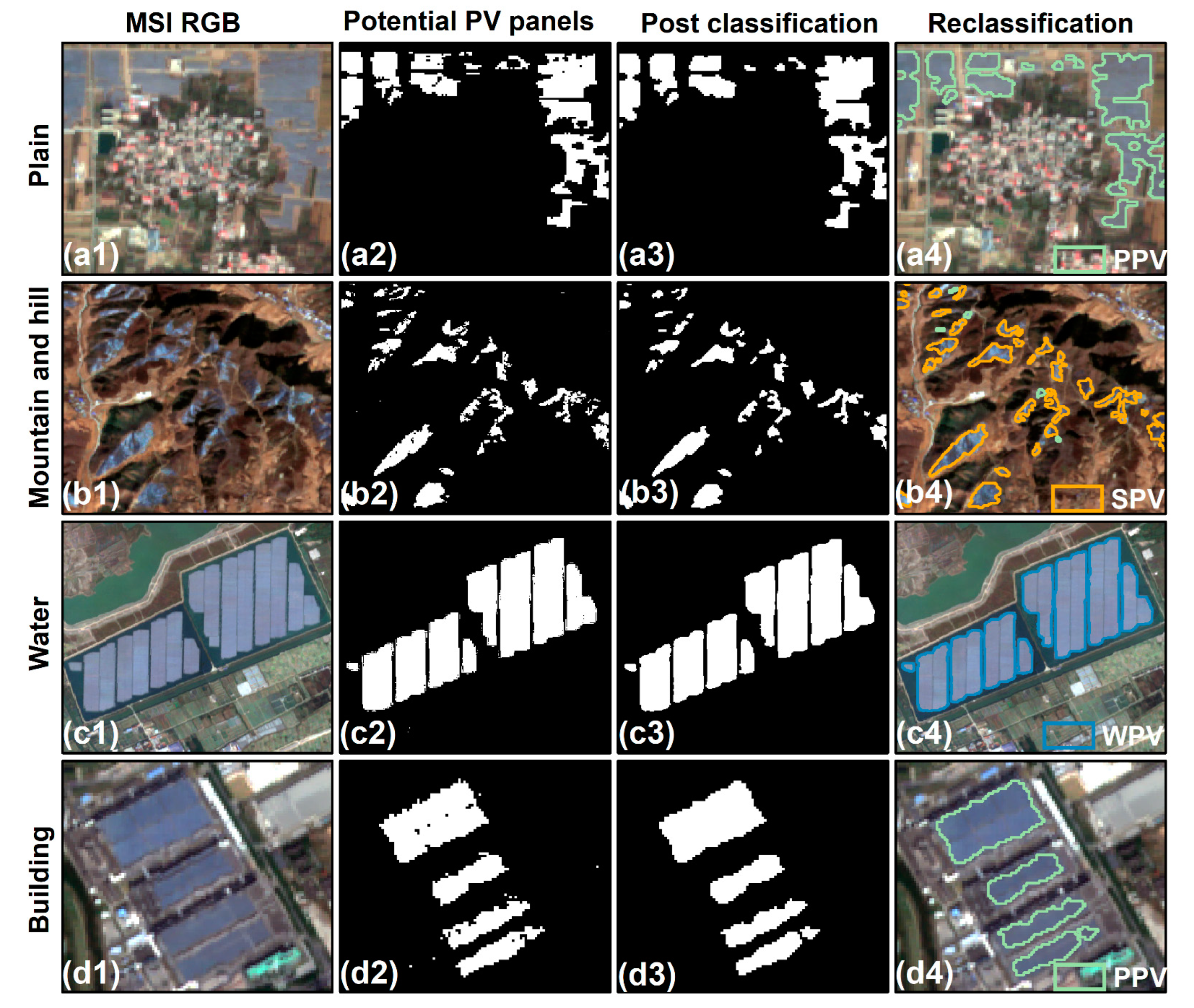
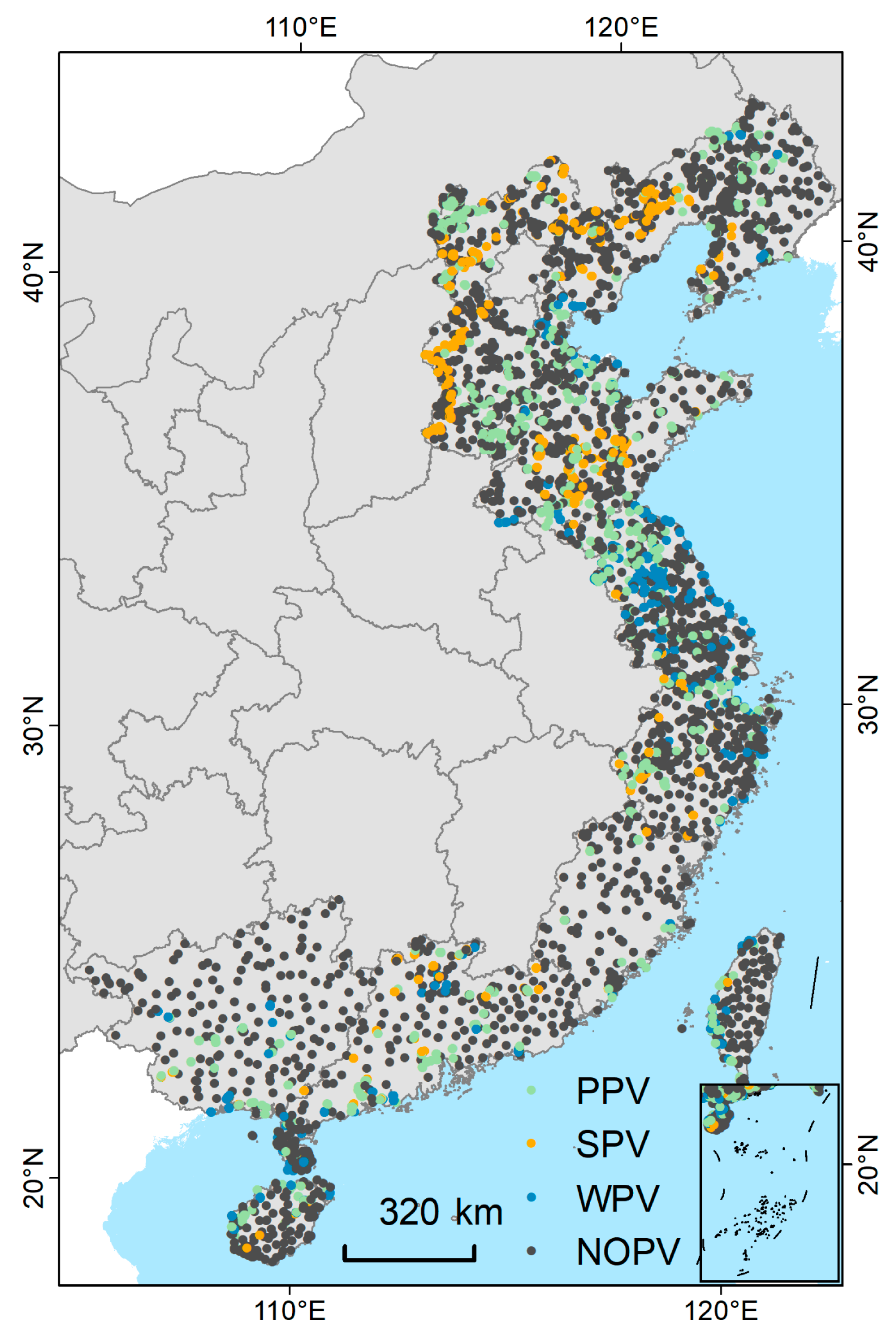



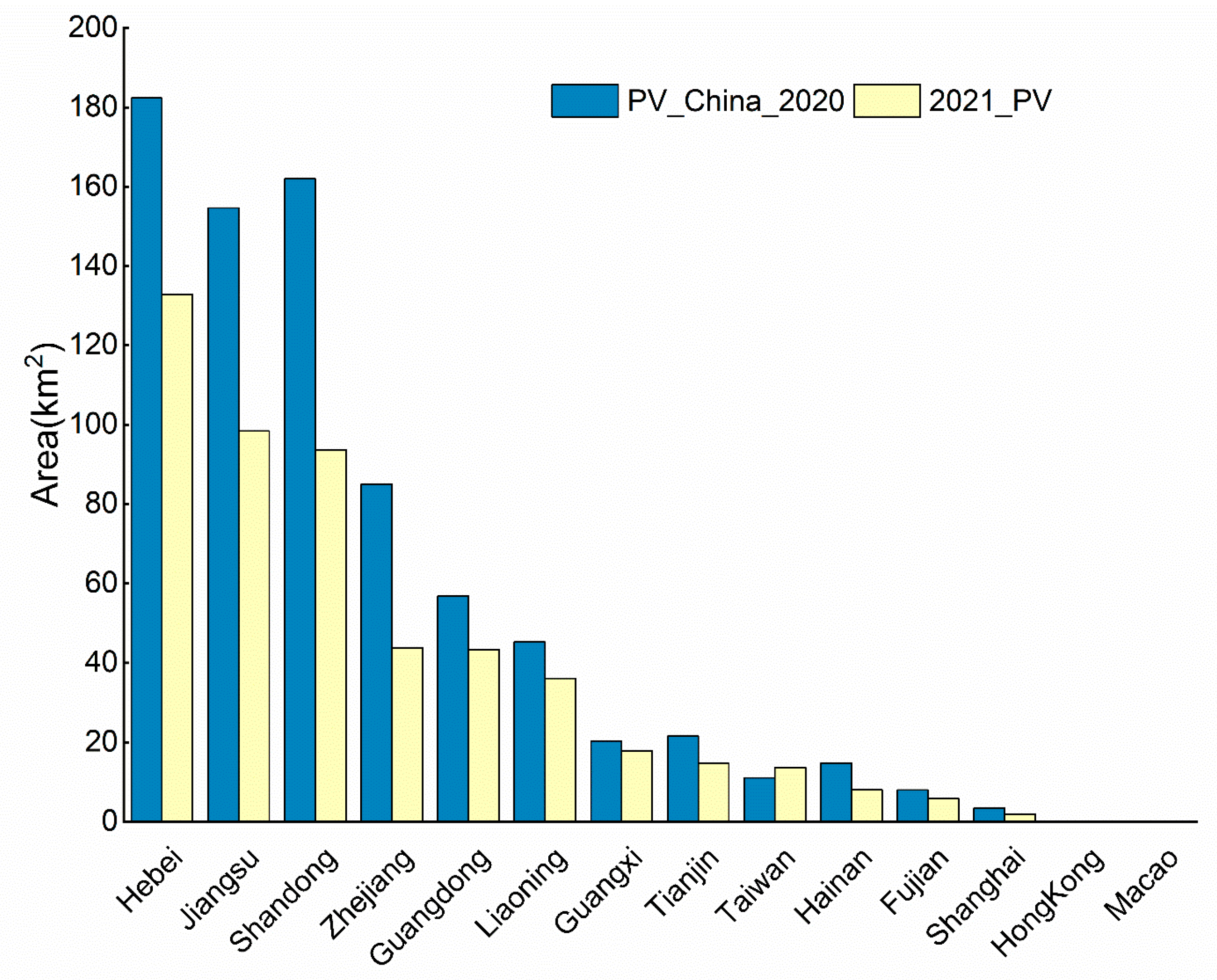
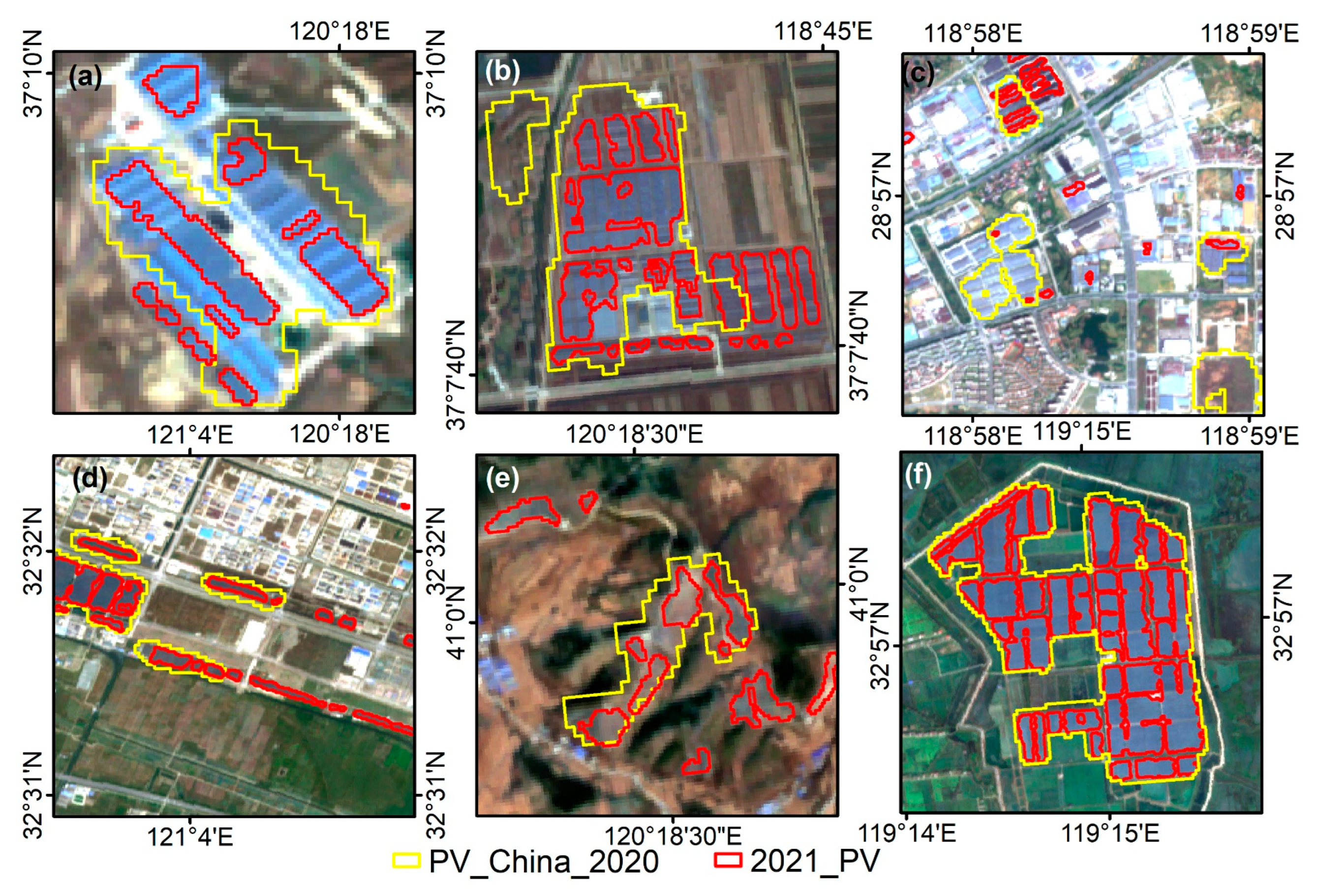
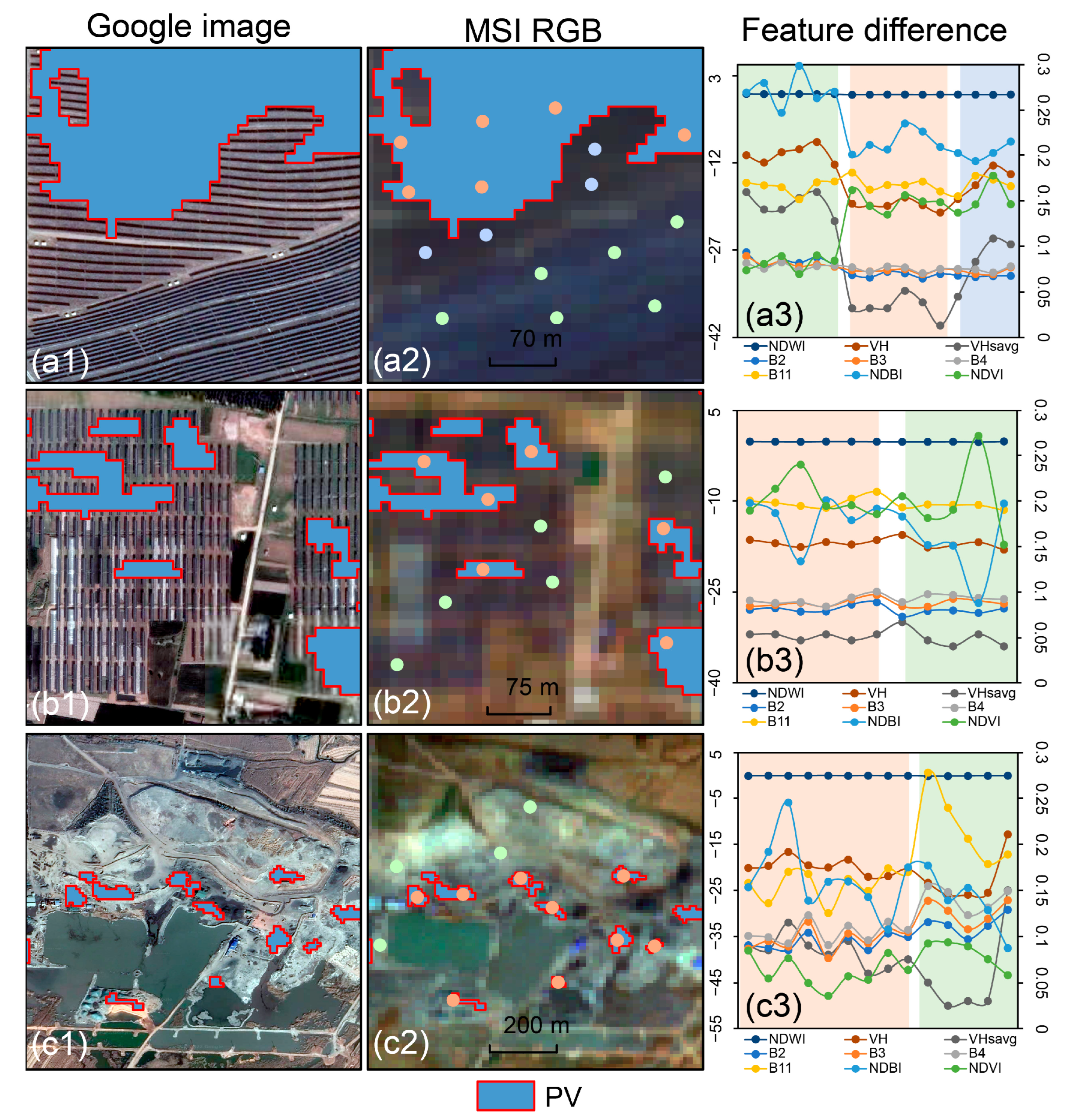

| NOPV | PV | Producer Accuracy | ||
|---|---|---|---|---|
| Potential photovoltaic | NOPV | 2697 | 288 | 97.93% |
| PV | 57 | 3958 | 93.22% | |
| User accuracy | 90.35% | 98.58% | 95.07% (OA) | |
| Post-classification | NOPV | 2712 | 443 | 98.47% |
| PV | 42 | 3803 | 89.57% | |
| User accuracy | 85.96% | 98.91% | 93.07% (OA) | |
| Reclassification | NOPV | 2736 | 380 | 99.35% |
| PV | 18 | 3866 | 91.05% | |
| User accuracy | 87.80% | 99.54% | 94.31% (OA) |
| NOPV | PPV | SPV | WPV | Producer Accuracy | |
|---|---|---|---|---|---|
| NOPV | 2736 | 220 | 117 | 43 | 99.35% |
| PPV | 12 | 1631 | 52 | 163 | 81.59% |
| SPV | 6 | 44 | 1003 | 4 | 85.51% |
| WPV | 0 | 104 | 1 | 864 | 80.45% |
| User accuracy | 87.80% | 87.78% | 94.89% | 89.16% | 89.06% (OA) |
| Climate Zones | PPV | SPV | WPV |
|---|---|---|---|
| Mid-temperate | 68.04 | 21.64 | 9.65 |
| South-temperate | 107.88 | 46.28 | 64.58 |
| North-subtropical | 35.37 | 2.92 | 70.31 |
| Mid-subtropical | 13.14 | 7.91 | 8.75 |
| South-subtropical | 27.23 | 6.32 | 16.64 |
| Mid-tropical | 3.32 | 0.45 | 0.36 |
Disclaimer/Publisher’s Note: The statements, opinions and data contained in all publications are solely those of the individual author(s) and contributor(s) and not of MDPI and/or the editor(s). MDPI and/or the editor(s) disclaim responsibility for any injury to people or property resulting from any ideas, methods, instructions or products referred to in the content. |
© 2023 by the authors. Licensee MDPI, Basel, Switzerland. This article is an open access article distributed under the terms and conditions of the Creative Commons Attribution (CC BY) license (https://creativecommons.org/licenses/by/4.0/).
Share and Cite
Zhang, H.; Tian, P.; Zhong, J.; Liu, Y.; Li, J. Mapping Photovoltaic Panels in Coastal China Using Sentinel-1 and Sentinel-2 Images and Google Earth Engine. Remote Sens. 2023, 15, 3712. https://doi.org/10.3390/rs15153712
Zhang H, Tian P, Zhong J, Liu Y, Li J. Mapping Photovoltaic Panels in Coastal China Using Sentinel-1 and Sentinel-2 Images and Google Earth Engine. Remote Sensing. 2023; 15(15):3712. https://doi.org/10.3390/rs15153712
Chicago/Turabian StyleZhang, Haitao, Peng Tian, Jie Zhong, Yongchao Liu, and Jialin Li. 2023. "Mapping Photovoltaic Panels in Coastal China Using Sentinel-1 and Sentinel-2 Images and Google Earth Engine" Remote Sensing 15, no. 15: 3712. https://doi.org/10.3390/rs15153712
APA StyleZhang, H., Tian, P., Zhong, J., Liu, Y., & Li, J. (2023). Mapping Photovoltaic Panels in Coastal China Using Sentinel-1 and Sentinel-2 Images and Google Earth Engine. Remote Sensing, 15(15), 3712. https://doi.org/10.3390/rs15153712







